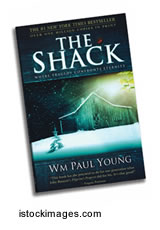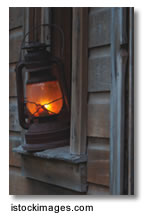by Rev. Steven B. Borst
As a Los Angeles Lakers fan, I remember with delight the three championships we won with Shaquille O’Neal. During his time in LA, opponents could barely contain the NBA’s “Superman.” Like Superman, however, O’Neal had one weakness. His kryptonite was free throws. The big man who did almost everything well often looked foolish at the foul line. Opponents, therefore, employed a tactic dubbed “Hack a Shaq.” They would purposely foul him to expose his weakness.
More recently, a similar tactic has been used on a book of Christian (although some vigorously dispute that characterization) fiction that made a fast break to the number-one position on the New York Times bestseller list last summer and, with more than 6 million copies in print, has remained there.
 The Shack is a visceral, moving story about redemption in a deeply broken world, and regardless of how one defines it, is being bought or borrowed by multitudes in Lutheran pews across the country. My first Bible-study class on the book ran more than three hours and failed to exhaust the conversation. I’ve made presentations to book clubs, circuit pastoral conferences, and other congregations, where the reception has been equally intense.
The Shack is a visceral, moving story about redemption in a deeply broken world, and regardless of how one defines it, is being bought or borrowed by multitudes in Lutheran pews across the country. My first Bible-study class on the book ran more than three hours and failed to exhaust the conversation. I’ve made presentations to book clubs, circuit pastoral conferences, and other congregations, where the reception has been equally intense.
Pastors and theologians, as I’ve noted, are divided on merits of The Shack. From a Lutheran Christian perspective, there are substantial doctrinal problems with the book, but does that mean it’s not worth reading as a novel—as a contemporary, and influential, work of fiction?
Some have employed a “Hack The Shack” approach, exposing the book’s weaknesses, but saying little about its merits. Others, of course, have endorsed it heartily, without even a nod to some of its significant theological shortcomings.
An Autobiographical Journey
The Shack was written by William Paul Young, who grew up as a missionary kid in New Guinea. Young was sexually abused as a boy, which left him emotionally and spiritually handicapped. Shortly after Young married, he committed adultery. It was then that he was forced to deal with the issues in his life. The Shack is really about how God deals with the sin and pain in our lives. In that sense, the book is more autobiographical than doctrinal.
Young wrote The Shack for his children with no intention of publishing it. Eventually, he sent the manuscript to a number of publishers, without success. With the help of some friends, he published the book himself, initially spending only $300 on marketing. Young describes the book’s radical success as “something God is doing.”
 The story of The Shack mirrors Young’s own experiences of loss and redemption. The novel centers on a character named Mackenzie, who deals with the loss of his young child, Missy. After Missy’s death, Mack is overcome by a “Great Sadness” and is very angry at God. A breakthrough occurs, when, by God’s initiative, Mack is invited to meet the Holy Trinity at the place where Missy’s body was found: in an abandoned shack in the dense forest of north-eastern Oregon.
The story of The Shack mirrors Young’s own experiences of loss and redemption. The novel centers on a character named Mackenzie, who deals with the loss of his young child, Missy. After Missy’s death, Mack is overcome by a “Great Sadness” and is very angry at God. A breakthrough occurs, when, by God’s initiative, Mack is invited to meet the Holy Trinity at the place where Missy’s body was found: in an abandoned shack in the dense forest of north-eastern Oregon.
This premise of the book strikes a deep chord with many Christians. The abandoned shack is a metaphor for the hurt in our lives. It’s that place where we experienced our deepest pain and where we hide our sin and shame. Though we try to avoid our own shacks, God in His mercy invites us to this place of pain for honest confession, grace, and healing.
This is what separates The Shack from most of the popular Christian works published today. Unlike The Promise or The Prayer of Jabez, which pedal a gospel of prosperity, The Shack deals with life under the cross and is not afraid to venture into the deep mysteries of faith. Admittedly, Young has trouble swimming in such deep waters, but that he has Christians exploring such doctrines as the Holy Trinity, the person and work of Christ, and the problem of sin and evil in our world is commendable. Indeed, if we examine the book in the light of Holy Scripture, five major themes appear, revealing both the book’s strengths and weaknesses.
The Holy Trinity
One of the shocking moments of the book is when Mack meets all three persons of the Trinity. Even if you have not read the book, you might have heard that the Father, called Papa, is depicted as an African American woman (though he changes appearances toward the end). As a gourmet chef, he creates. Jesus appears as himself, and looks like a Middle Eastern man, with “no beauty . . . to attract us to him” (Is. 53:2 NIV). Dressed as a carpenter, he serves. The Holy Spirit appears as an Asian woman. As a gardener, she nurtures. Young fully develops each person and creates some memorable interactions between them. At the same time, God/Papa clearly states that he is one essence, and freely refers to himself as both “we” and “I.”
There are serious problems in Young’s depiction, however. Because he tries carefully not to give the impression that the three persons are three different gods (a difficult assignment when writing fiction), he ends up minimizing the uniqueness of each person in order to emphasize God’s unity. For example, the Father talks about himself becoming human, and is depicted as having nail marks on his hands. Further, Young’s Jesus never uses his own divinity but must instead rely on the Father’s divine power. Finally, and perhaps most troubling, Young robs Jesus of what He fully accomplished in redemption, suggesting that the Father didn’t damn the Son on the cross, but instead remained with Him, which clearly contradicts Jesus’ cry from the cross: “My God, My God, Why have You forsaken Me?” (Mark 15:34). Gal. 3:13 clearly states: “Christ redeemed us from the curse of the Law by becoming a curse for us, for it is written: ‘Cursed is everyone who is hung on a tree.’”
Relationships
Young describes beautifully that humanity was created for loving relationships, and that the Holy Trinity is the source for such intimate fellowship with God and one another (see John 17:25–26). This is a profound insight: All love flows from the three persons, who relate to one another in perfect unity as one essence. God is love. Therefore, the Father invites Mack to call him “Papa,” a clear reference to the Aramaic Abba (“Daddy”) found in Rom. 8:15.
At the same time, Young clearly has a strong bias against institutions because, he says, they are based on power and not love. He criticizes government, as well as the church. While he correctly points out the abuse of serving institutions over people, Young takes this to the extreme. He has Jesus claiming that institutions are not His creation nor His will. This clearly conflicts with a Lutheran understanding of the two kingdoms (see Matt. 16:16–20 and Rom. 13:1–2). It’s important to note that Young claims no church affiliation. This is unfortunate, not only because he has separated himself from Christ’s Body, but also in that he has distanced himself from the wisdom of pastors and elders who could have helped him with the doctrinal problems in his book!
Salvation
 There is much debate on whether Young defends salvation by grace through faith on account of Christ. Sometimes this is clearly stated, while at other times his language is ambiguous. When interviewed, Young rebuts any claims of universalism and defends the centrality of Christ’s redemption. In the book, Papa does state that everything points to Jesus, and only through Him is the world reconciled. Indeed, God’s unconditional love on account of Christ is the major message of the book. Conspicuously absent, however, is the idea of God’s wrath and judgment. God doesn’t seem to get angry at sin or to judge it, and the book doesn’t deal with those who don’t come to faith. The devil is not mentioned, nor is hell. In fairness to Young, his central character is a Christian, so such matters might be beyond the scope of the novel.
There is much debate on whether Young defends salvation by grace through faith on account of Christ. Sometimes this is clearly stated, while at other times his language is ambiguous. When interviewed, Young rebuts any claims of universalism and defends the centrality of Christ’s redemption. In the book, Papa does state that everything points to Jesus, and only through Him is the world reconciled. Indeed, God’s unconditional love on account of Christ is the major message of the book. Conspicuously absent, however, is the idea of God’s wrath and judgment. God doesn’t seem to get angry at sin or to judge it, and the book doesn’t deal with those who don’t come to faith. The devil is not mentioned, nor is hell. In fairness to Young, his central character is a Christian, so such matters might be beyond the scope of the novel.
The Means of Grace
Encountering God is the major literary device that propels the novel forward. Young speaks of an incarnational God who is willing to limit Himself to interact with humanity. Indeed, that Young has the Father and Spirit hide in temporary corporal bodies to meet with Mack is not unlike some of God’s appearances in the Old Testament as a stranger to Abraham or a wrestler with Jacob. Largely absent, though, is the means of grace as the place where we meet God. The Spirit is weakly connected to the Word of God on several occasions, and the Lord’s Supper subtly appears before a key event in the book. Most of the time, however, Young has the Holy Spirit acting apart from the means of grace. He maligns Christians for overemphasizing Scripture and instead emphasizes visions and dreams as the place to hear God’s voice.
Freedom in Christ
Young does an excellent job of differentiating between a life led by the sinful nature and a new life lived in Christ. Sin is described as independence from God— a rebellion against His will to follow our own. Thus, the Ten Commandments are chiefly a mirror to show us our sin. Even though God can bring good out of the evils of sinful humanity, He is not the source of this evil. Conversely, Young depicts sanctification as true freedom in Christ. Since the Law has no ability to produce good works in us, we are set free to live in the grace that God provides. Young would have us throw away our WWJD bracelets and instead live our lives as branches connected to Christ, our Vine.
Hack or Back?
There is much more to explore in The Shack, such as faith, forgiveness, fellowship, marriage, vocation, and heaven. In the end, Lutheran pastors and congregations are left with this question: Do we hack or back The Shack? Perhaps it is helpful to remember that Young set out to compose a story, and not a systematic treatise, about God. It isn’t meant to replace our Catechism. So, if this tale sparks conversation among Christians, causing us to explore its claims in light of Holy Scripture, then, perhaps, The Shack is a modern novel worthy of our consideration.





